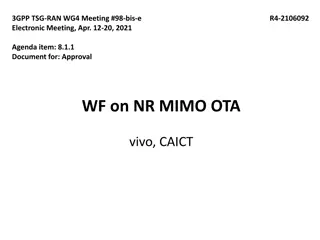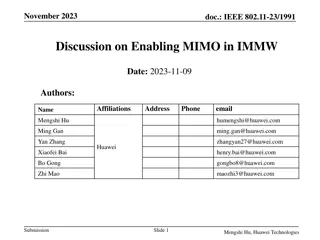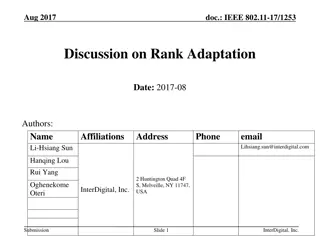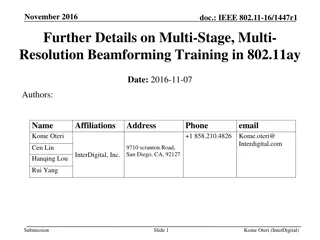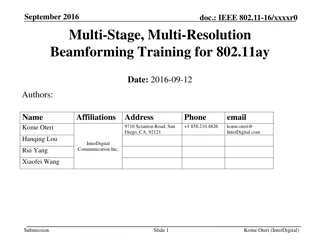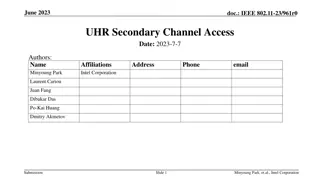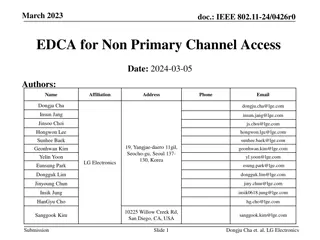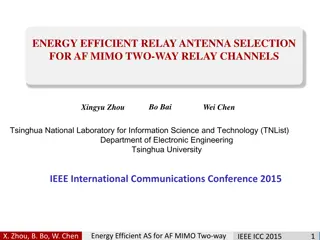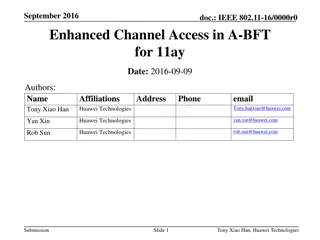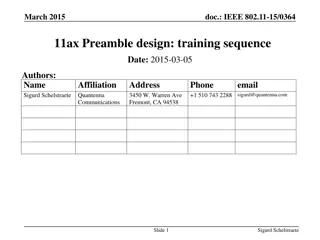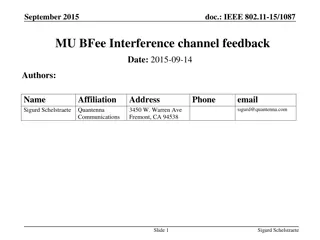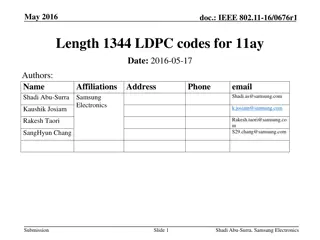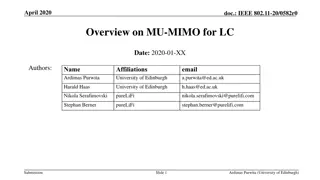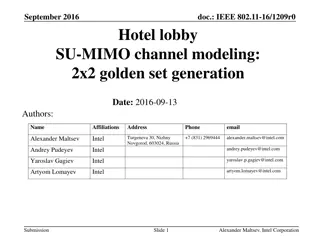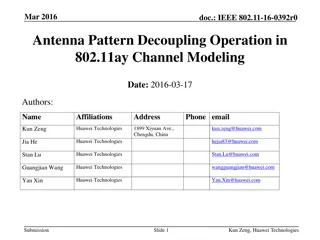
MU-MIMO Channel Access Flow for IEEE 802.11ay Standard
Explore the proposed schemes for MU-MIMO channel access flow in IEEE 802.11-16/1408r0 presentation, aiming to facilitate MU-MIMO data transmission efficiently through detailed outlined processes and methods discussed by industry experts from various technological backgrounds.
Download Presentation

Please find below an Image/Link to download the presentation.
The content on the website is provided AS IS for your information and personal use only. It may not be sold, licensed, or shared on other websites without obtaining consent from the author. If you encounter any issues during the download, it is possible that the publisher has removed the file from their server.
You are allowed to download the files provided on this website for personal or commercial use, subject to the condition that they are used lawfully. All files are the property of their respective owners.
The content on the website is provided AS IS for your information and personal use only. It may not be sold, licensed, or shared on other websites without obtaining consent from the author.
E N D
Presentation Transcript
doc.: IEEE 802.11-16/1408r0 MU-MIMO channel access flow for 11ay Date: 2017-09-01 Authors: Name Tony Xiao Han Affiliations Huawei Technologies Address Phone email Tony.hanxiao@huawei.com Huawei Technologies Min Yan Huawei Technologies Qian Wang Huawei Technologies Wei Lin Huawei Technologies Peter Loc Huawei Technologies Yan Xin Cheng Chen Intel Carlos Cordeiro Intel Solomon Trainin Qualcomm Jinsoo Choi LG Slide 1
doc.: IEEE 802.11-16/1408r0 Outline Background and motivation Scheme 1: DMG CTS-to-self Scheme 2: Simultaneous DMG CTS Conclusion Slide 2
doc.: IEEE 802.11-16/1408r0 Background and motivation This presentation proposes following schemes for MU-MIMO channel access flow, the goal is to set up a MU-MIMO TXOP and start MU-MIMO data transmission. Scheme 1: DMG CTS-to-self Scheme 2: Simultaneous DMG CTS Assumption Prior to the transmission of an EDMG MU PPDU to a set of responder STAs within an MU group, the initiator shall Includes the MU group within the EDMG Group ID Set element and communicate the resulting element to the STAs in the BSS Perform MU-MIMO beamforming with the responders of the MU group. Slide 3
doc.: IEEE 802.11-16/1408r0 Scheme 1: DMG CTS-to-self An EDMG STA establishes an MU-MIMO TXOP by transmitting a DMG CTS-to-self frame to the intended MU-MIMO group of responders. The EDMG STA shall transmit the DMG CTS-to-self frame with a control trailer to the group of responders to indicate the intent to transmit an EDMG MU PPDU. The EDMG Group ID is include in the control trailer The MU-MIMO transmission begins SIFS interval following the end of the DMG CTS- to-self frame transmission by the initiator. DMG CTS-to-self CT CT DMG CTS-to-self MU-MIMO Initiator CT DMG CTS-to-self SIFS MU MPDU transmission and reception MU-MIMO Responder 1 MU-MIMO Responder 2 MU-MIMO Responder 3 MU-MIMO antenna setting CT: Control Trailer Slide 4
doc.: IEEE 802.11-16/1408r0 Scheme 2: Simultaneous DMG CTS An EDMG STA establishes an MU-MIMO TXOP by transmitting an RTS frame to the intended MU- MIMO group of responders. The EDMG STA shall transmit the RTS frame with a control trailer to the group of responders to indicate the intent to transmit an EDMG MU PPDU. The EDMG Group ID is include in the control trailer A STA that receives an RTS frame addressed to an MU group that the STA belongs to shall transmit a DMG CTS frame back to the initiator employing the most recent SISO antenna configuration used between the responder and the initiator. (More explanation in the next slide) The MU-MIMO transmission begins SIFS interval following the reception or expected reception of the DMG CTS frame by the initiator. RTS CT CT RTS MU-MIMO Initiator CT RTS SIFS MU PPDU transmission and receiving DMG CTS MU-MIMO Responder 1 DMG CTS MU-MIMO Responder 2 DMG CTS MU-MIMO Responder 3 SIFS MU-MIMO antenna setting SISO CT: Control Trailer antenna setting Slide 5
doc.: IEEE 802.11-16/1408r0 Scheme 2: Simultaneous DMG CTS For the simultaneous DMG CTS The TA field of the DMG CTS shall be set to the broadcast MAC address and the Scrambler Initialization field in the PHY header shall be set to the same value as the Scrambler Initialization field of the PPDU that contained in the received RTS frame. For the STA addressed by the DMG CTS frame to successfully receive the frame, the difference in time between all the DMG CTS transmissions as measured at the receiving STA should be no more than 30 ns. A STA that transmits the DMG CTS should pre-compensate for carrier frequency offset (CFO) error. After compensation, the absolute value of residual CFO error with respect to the RTS should not exceed 12KHz. (The simulation and analysis for time delay and CFO error are shown in the following slides.) RTS CT CT RTS MU-MIMO Initiator CT RTS SIFS MU PPDU transmission and receiving DMG CTS MU-MIMO Responder 1 DMG CTS MU-MIMO Responder 2 DMG CTS MU-MIMO Responder 3 SIFS MU-MIMO antenna setting SISO CT: Control Trailer antenna setting Slide 6
doc.: IEEE 802.11-16/1408r0 Scheme 2: Simultaneous DMG CTS (Simulation and analysis for time delay) Simulation setting: Control PHY (MCS0) Conference room, NLOS Channel STA to AP Scenario Time delay: 0~80ns Rake Equalization Simulation packets number = 3000 Frame length = 20 Bytes (Length of DMG CTS) Result: when the time delay is less than or equal to 60ns, the performance is very close When the time delay is greater than 60ns, the significantly degrades. performance Time delay: is the difference in time between the DMG CTS responses from the STAs as measured at the AP. Slide 7
doc.: IEEE 802.11-16/1408r0 Scheme 2: Simultaneous DMG CTS (Simulation and analysis for time delay) Analysis fundamentally : The structure of CEF is shown as the following figure Channel estimation can be conducted at the receiver by performing cross-correlation between received signal and the stored local Golay sequences. Assuming the received signal R = [-Ga128 Gu512 Gv512 Gv128], the local Golay sequences ref = [Gu512 Gv512] The result of cross-correlation between R and ref is showed as the following figure, which is a delta function in the zone circled in red. The max delay spread (time delay) should not exceed 128 samples, which is 128*1/1.76GHz=72 ns. The 72 ns need to cover, e.g., STA TX chain jitter and DL timing bias. Conclusion: Based on the simulation results and analysis, 30 ns could be considered as the requirement of time delay. Hence, the absolute time delay is less than or equal to 60ns, with 12ns margin to cover the delay spread of single PPDU. Slide 8
doc.: IEEE 802.11-16/1408r0 Scheme 2: Simultaneous DMG CTS (Simulation and analysis for carrier frequency offset (CFO) error) Simulation setting: Control PHY (MCS0) Conference room, NLOS Channel STA to AP Scenario AP Antenna pattern: Isotropic radiator STA Antenna pattern: basic steerable direction antenna Rake Equalization Simulation packets number = 3000 Frame length = 20 Bytes Different CFO error after pre-compensation Result: When the frequency error 12KHz(0.2ppm), the performance is very close. When the frequency error is greater than 12KHz(0.2ppm), the performance significantly degrades. is below Hence, A STA that transmits the DMG CTS should pre-compensate for carrier frequency offset (CFO) error. After compensation, the absolute value of residual CFO error with respect to the RTS should not exceed 12KHz(0.2ppm). Note: Slide 9
doc.: IEEE 802.11-16/1408r0 Conclusion Two MU-MIMO channel access schemes are proposed and compared. Scheme 1: DMG CTS-to-self Scheme 2: Simultaneous DMG CTS Slide 10
doc.: IEEE 802.11-16/1408r0 Straw Poll/Motion Do you agree to include the text for MU-MIMO Channel access flow proposed in 11-17-1409-00-00ay-Draft text for MU-MIMO channel access flow for 11ay.docx to the spec draft? Voting Yes/No/Abstain Slide 11


